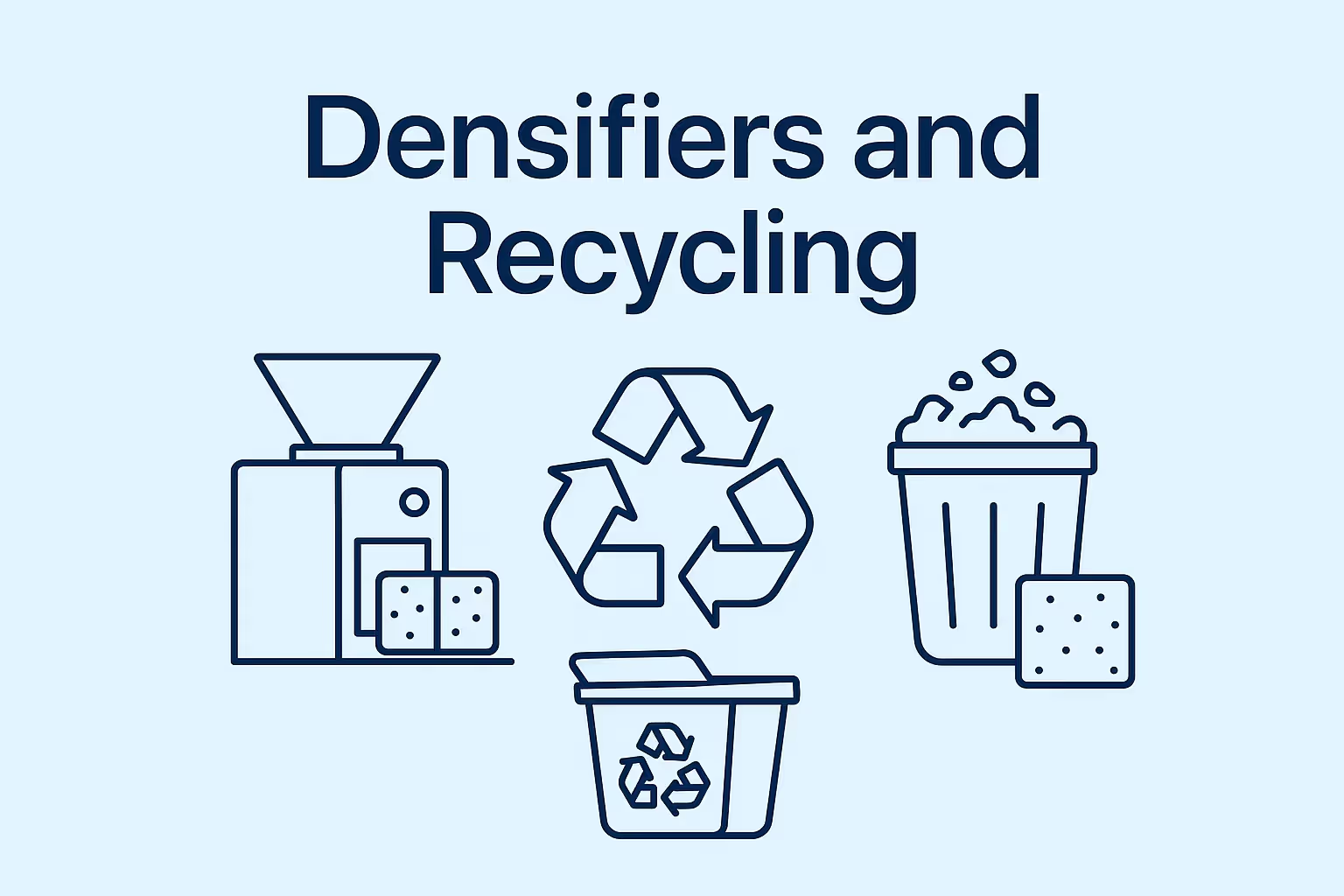Densifiers transform lightweight plastic waste into compact, manageable material—reducing volumes by up to 90:1 while making recycling economically viable. Whether you’re managing EPS foam packaging or plastic film waste, understanding densifier technology can improve waste operations and support a circular economy.
Densifiers are now common in recycling facilities, manufacturing plants, and waste management operations. Unlike standard compactors that handle mixed waste, densifiers specialize in specific plastics, achieving volume reductions far beyond conventional compression.
How Densifier Technology Works
Compared to compactors that only press materials, densifiers combine targeted heat and mechanical force to change a plastic’s physical structure. This is why densifiers can reach volume reduction ratios of 50:1 to 90:1, versus ~20:1 for compactors.
Typical stages:
- Infeed and pre‑size reduction: Manual or automated feeding, then knives or screws prepare consistent pieces for even processing.
- Controlled heating: External heaters or friction heat bring material to its softening point without degrading polymers.
- Compression and forming: Material is compacted into logs/blocks or agglomerated granules depending on the technology.
Throughput varies by machine and material. Modern foam densifiers commonly process 200–1,500 lb/h. Film agglomerators for PE/PP operate at 500–1,000 kg/h in industrial settings.
Materials Suitable for Densification
Expanded Polystyrene (EPS) and Styrofoam
EPS and Styrofoam are ~98% air, extremely bulky yet light. Both densify well, though their densities/additives may require tuning. Food‑service foam may need pre‑cleaning when heavily soiled to maintain output quality.
Plastic Films and Flexible Packaging
Polyethylene films (bags, stretch wrap, agricultural films) are best handled by agglomerators. Agglomerators use aggressive cutting and frictional heating so plastic pieces partially fuse into uniform granules that feed cleanly into extrusion.
Processing capacity: Industrial film agglomerators typically handle 500–1,000 kg/h, converting loose films into dense granules ready for pelletizing.
Types of Densifiers
Cold Compression Densifiers
Rely purely on mechanical pressure (hydraulic/electric rams) to collapse air cells—no added heat. Produces continuous squared logs/blocks for easy storage and transport. Suitable where heat is a concern or polymer degradation must be avoided.
Hot‑Melt Densifiers
Apply controlled heat before compression to achieve higher densities (up to ~90:1 on EPS). Material extrudes as compact ingots/blocks. Multistage heating and water cooling help avoid polymer damage and stabilize output.
Agglomerators (for Films)
Purpose‑built for films and flexible plastics. Rotating/stationary blades shred while friction generates heat. Water injection and screens manage cooling and sizing; oversize particles are automatically reprocessed for consistent granules.
Environmental Case for Densification
According to the U.S. Environmental Protection Agency, plastics are a growing fraction of municipal solid waste. Densification directly reduces landfill volume and enables higher‑value recycling pathways.
- EPS: Extremely voluminous; densification makes transport and recycling practical. Densified EPS can be reprocessed into new foam, frames, molding, and more.
- Films: Lightweight films escape collection and pollute waterways. Densification makes films manageable across the recycling chain, reducing environmental leakage.
Environmental benefits:
- Cuts landfill volume up to 90%
- Enables closed‑loop use of petroleum‑based plastics
- Reduces plastic leakage into oceans and waterways
- Lowers GHG footprint via virgin‑material displacement
Economic benefits:
- 50–90% lower storage and transport costs
- New revenue from sale of densified material
- Lower disposal fees; access to grants/tax incentives
- Efficiency gains from in‑house recycling
Reference: https://www.epa.gov/facts-and-figures-about-materials-waste-and-recycling
Economic Considerations: ROI and Costs
Payback depends on waste volume, material mix, local disposal costs, and markets. High‑volume foam or film generators often see sub‑two‑year ROI.
- Freight savings: One truck of densified EPS can replace dozens of loose‑foam loads.
- Market value: Densified EPS often sells for $200–$400/ton depending on quality and region.
- In‑house value: Manufacturers can offset 15–30% of virgin purchases by reclaiming scrap.
- TCO: Consider energy, maintenance, knives/screens, and labor. Equipment ranges: foam densifiers ~$15k–$100k+, film agglomerators ~$50k–$200k+ depending on throughput.
Selecting the Right Densifier
Material Characteristics
Match equipment to your plastics (clean EPS vs. mixed/contaminated films). Measure both weight and cubic volume to size capacity correctly.
Feed System Requirements
Manual feed suits small volumes; automated conveyors/hoppers are best for higher throughput or continuous scrap from production lines.
Output Specifications
Blocks/logs vs. granules—confirm buyer preferences for density, dimensions, or format.
Operational Environment
Validate floor space, power (often 3‑phase), ventilation (for hot‑melt), noise, and safety interlocks.
Future Expansion
Prefer modular systems that scale: manual → automated feed, cold → hot‑melt, added capacity modules.
Rumtoo Machine Densifier Solutions
Rumtoo offers compact units for small operations and high‑capacity automated systems for industry. Foam densifiers feature precise temperature control to avoid polymer degradation. Film agglomerators handle clean to contaminated PE/PP streams with consistent granule quality. We support assessment, installation, and maintenance, and can help estimate ROI for your specific waste profile.
Making Your Densification Decision
Start by benchmarking your waste stream (type, contamination, volume consistency). Estimate savings from disposal reduction, freight consolidation, and sales of densified material; include grants or incentives when available. Compare suppliers on operating costs, maintenance, warranty, and service, and ask for references or trials with your materials. Densification often delivers the most value as part of a broader system integrated with balers, shredders, washing, and pelletizing.
Conclusion
Densification is a proven, economical way to manage foam and film waste. With the right machine, you gain lower logistics costs, better recycling outcomes, and measurable sustainability impact. Ready to evaluate options? Contact Rumtoo Machine to review your waste profile and select a densifier or agglomerator tailored to your goals.
